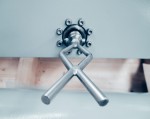- Home » Editorial » Hydraulics
State-of-the-art hydraulics for floating megastructure

The offshore industry is one of the harshest environments to work in, for both machinery and personnel. Salt water can corrode parts and strong winds and crashing waves can damage equipment.
In addition, many offshore work locations are miles from land. Rigs can be inaccessible for long periods at a time, meaning that for the safety of personnel (and the protection of the environment), all equipment must be state-of-the-art and have undergone rigorous safety checks. The development, manufacture and testing of this equipment are highly specialised disciplines, with continuous advancements being made. Each project is carefully designed, with experts in each field being commissioned to manufacture individual parts and third-party inspection agencies carefully overseeing the project as a whole.
Hydraulic cylinder specialist Apex Hydraulics was commissioned to build four bespoke cylinders, designed by a multinational oil corporation for a Floating Liquefied Natural Gas rig (FLNG).
FLNGs are the world’s largest floating structures. They are designed to process gas at source; liquefying useable product directly from the unrefined material brought up from the seabed and sending only this back to shore by oil tanker. Avoiding the transportation of gas to shore to be refined in onshore facilities can save a substantial amount of money and be better for the environment.
FLNG’s are gradually being based further from shore, as new discoveries of oil and gas are being found in increasingly remote locations; often at depths of up to quarter of a kilometer. The large structures need to be anchored to the sea bed to keep them in place.
Gas is taken up to the FLNG via four flowlines, held in place by suction piles. It is vital that these pipes are constantly held in tension to avoid any damage occurring. Hydraulic cylinders shorten the flowlines by tightening them until they reach the required tension.
Due to the depths at which this is being carried out, these cylinders are operated by a Remote Operated Vehicle (ROV) via a hot stab receptacle. This is completed with matching live and dummy stabs; a communal hydraulic port and accessories that can operate a double-acting cylinder whilst being subsea.
The hot stab receptacle creates an open port interface on the hydraulic cylinder and the ROV can then use the live hot stab assembly to provide the advance and retract hydraulic pressures to work the cylinder.
The working dimensions of these cylinders were 250mm bore, 120mm rod with a 1850mm stroke. The rod was made from hard chrome plated 1.4418 stainless steel. The hot stab receptacle and dual counterbalance valve manifold block were manufactured in duplex stainless steel, complemented by live and dummy hot stab assemblies cast in Nitronic 60 stainless steel complete with 316L stainless steel ROV friendly fishtail handles.
-
PPMA 2025
23 September, 2025, 9:30 - 25 September, 2025, 16:00
NEC, Birmingham UK -
Advanced Engineering Show 2025
29 October, 2025, 9:00 - 30 October, 2025, 16:00
NEC, Birmingham UK










